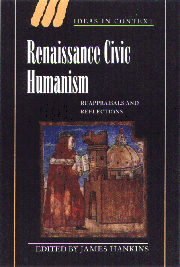Book contents
- Frontmatter
- Contents
- List of contributors
- Introduction
- 1 The republican idea
- 2 “Civic humanism” and medieval political thought
- 3 Civic humanism and Florentine politics
- 4 The two myths of civic humanism
- 5 Rhetoric, history, and ideology: the civic panegyrics of Leonardo Bruni
- 6 De-masking Renaissance republicanism
- 7 Civic humanism, realist constitutionalism, and Francesco Guicciardini's Discorso di Logrogno
- 8 Bruni and Machiavelli on civic humanism
- 9 Rhetoric, reason, and republic: republicanisms – ancient, medieval, and modern
- 10 Situating Machiavelli
- Index of manuscripts and archival documents
- General index
- Ideas in context
8 - Bruni and Machiavelli on civic humanism
Published online by Cambridge University Press: 06 October 2009
- Frontmatter
- Contents
- List of contributors
- Introduction
- 1 The republican idea
- 2 “Civic humanism” and medieval political thought
- 3 Civic humanism and Florentine politics
- 4 The two myths of civic humanism
- 5 Rhetoric, history, and ideology: the civic panegyrics of Leonardo Bruni
- 6 De-masking Renaissance republicanism
- 7 Civic humanism, realist constitutionalism, and Francesco Guicciardini's Discorso di Logrogno
- 8 Bruni and Machiavelli on civic humanism
- 9 Rhetoric, reason, and republic: republicanisms – ancient, medieval, and modern
- 10 Situating Machiavelli
- Index of manuscripts and archival documents
- General index
- Ideas in context
Summary
Civic humanism is not a new topic, but it is not a small one either. The term was coined by Hans Baron in 1925, writing in German, as Bürgerhumanismus, and it is elaborated in his chief work, The Crisis of the Early Italian Renaissance (1955, 1966). The “crisis” was the challenge to republican Florence in 1402 from absolutist Milan, which was resolved or at least met by “civic humanism,” a movement of humanist orators, poets, and philosophers, hitherto unpolitical, or if political not thoroughly republican, into “civic” affairs, that is, republican partisanship. Of course the challenge had to be met in politics and on the field of battle by civic Florentines, but a “civic humanist” is, in the usage of historians, always a thinker or a writer who is shaped by, or gives shape to, the civic spirit of the city. Even though Baron tries to draw the closest connections between political or military events and the writers, thus implying that events come first, his interest is in the writers as expressions or interpreters – in those who come second.
Baron defines the advent of civic humanism, coming as it does after a crisis, as a “break” between Francesco Petrarch's uncivic humanism of the Trecento and Leonardo Bruni's civic humanism of the Quattrocento. Almost immediately after speaking of a break, Baron refers to a “gradual process of fusion” leading from Coluccio Salutati and Filippo Villani to Bruni, and then immediately recoils from that concession, doubting that there could be fusion between citizens of a republic and aloof scholars or courtiers of a tyrant.
- Type
- Chapter
- Information
- Renaissance Civic HumanismReappraisals and Reflections, pp. 223 - 246Publisher: Cambridge University PressPrint publication year: 2000
- 3
- Cited by

